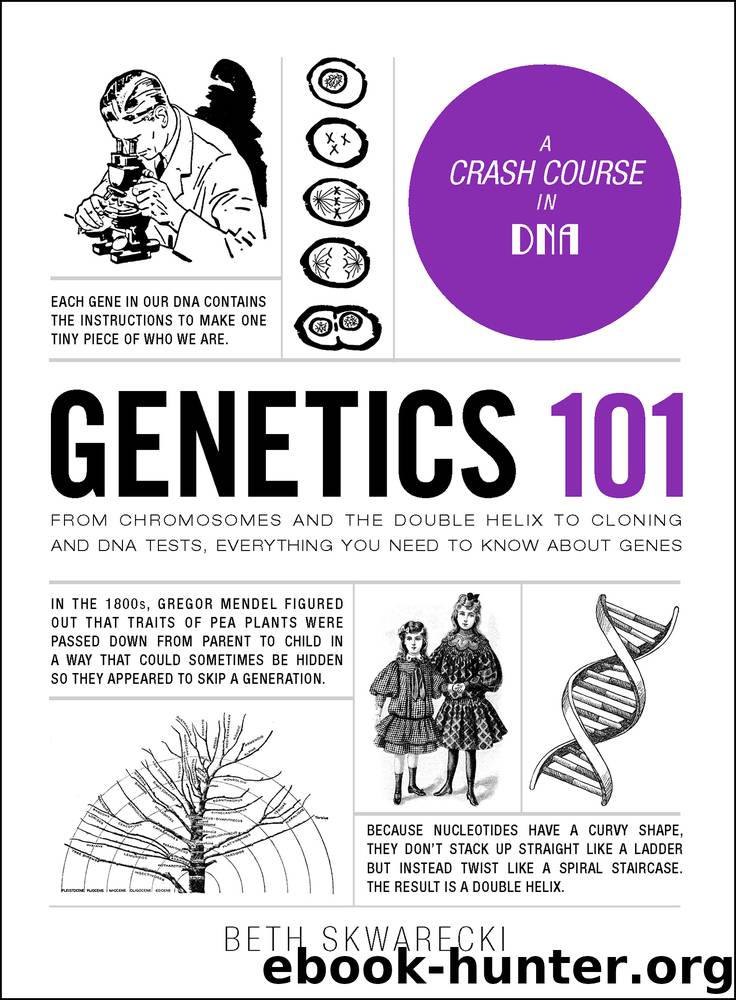Genetics 101 by Beth Skwarecki

Author:Beth Skwarecki
Language: eng
Format: epub, mobi
Publisher: Adams Media
EPIGENETICS
The Environmental Mark
By now we’re used to thinking of DNA as a way of storing information. But the information that’s coded in the sequence of nucleotides (A, T, G, C) isn’t all. Your DNA also carries epigenetic information, which can change while the sequence of bases stays the same.
Epigenetics literally means “on the genome.” The cell can make changes by adding methyl groups (a carbon and three hydrogens) to certain parts of the DNA, or it can add other groups of atoms to specific places on the histone proteins that are snuggled up next to specific parts of the DNA.
These changes affect which parts of the DNA get transcribed into RNA, and thus they dictate what genes are expressed. Epigenetic modifications to the DNA are changes in gene expression that persist even when the DNA is replicated. When a cell divides, both copies end up with not just their parent cell’s DNA sequence, but also their parent cell’s epigenetic modifications: those methyl groups and histone tags that can continue to direct gene expression even after the cell divides.
These changes persist when a cell divides, but that doesn’t mean you inherited them from your parents. Before an egg and sperm meet, some of their epigenetic modifications are reset, so you get the chance to come up with your own. But we do know that some epigenetic changes seem to be heritable from parents to children. Just be aware that when we talk about epigenetics, that’s only one small piece of how they work.
Download
This site does not store any files on its server. We only index and link to content provided by other sites. Please contact the content providers to delete copyright contents if any and email us, we'll remove relevant links or contents immediately.
Sapiens: A Brief History of Humankind by Yuval Noah Harari(14327)
The Tidewater Tales by John Barth(12629)
Mastermind: How to Think Like Sherlock Holmes by Maria Konnikova(7281)
Do No Harm Stories of Life, Death and Brain Surgery by Henry Marsh(6910)
The Thirst by Nesbo Jo(6882)
Why We Sleep: Unlocking the Power of Sleep and Dreams by Matthew Walker(6661)
Life 3.0: Being Human in the Age of Artificial Intelligence by Tegmark Max(5520)
Sapiens by Yuval Noah Harari(5328)
The Longevity Diet by Valter Longo(5044)
The Body: A Guide for Occupants by Bill Bryson(5035)
The Rules Do Not Apply by Ariel Levy(4913)
The Immortal Life of Henrietta Lacks by Rebecca Skloot(4552)
Animal Frequency by Melissa Alvarez(4431)
Why We Sleep by Matthew Walker(4398)
The Hacking of the American Mind by Robert H. Lustig(4342)
Yoga Anatomy by Kaminoff Leslie(4336)
All Creatures Great and Small by James Herriot(4277)
Double Down (Diary of a Wimpy Kid Book 11) by Jeff Kinney(4245)
Embedded Programming with Modern C++ Cookbook by Igor Viarheichyk(4145)
